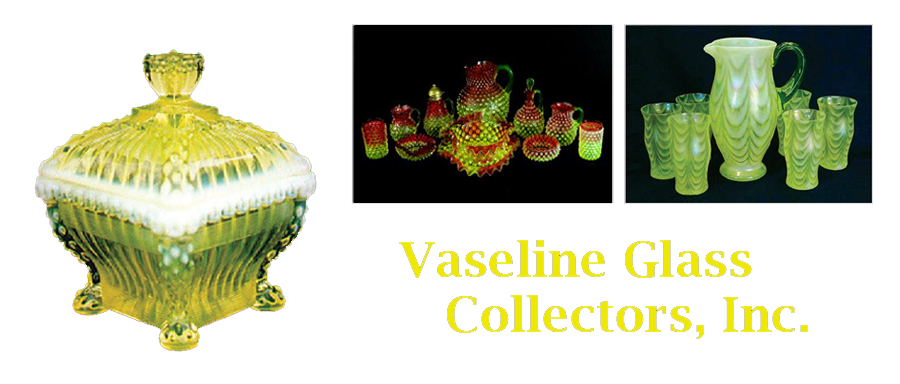

I recently purchased this Art Nouveau glass IRIS on an eBay.uk.com auction (shown above in three different lighting methods) that was made in opalescent vaseline glass. My all time favorite pattern is Iris With Meander by Jefferson Glass Co. and I thought this piece would be a nice accent piece for the rest of my collection. From the pictures on the internet auction site, it also looked like it might be possible to make it the centerpiece in a stained glass panel. The glass IRIS form is 4 3/4” left-to-right and 4 1/2” top-to-bottom. It is about an inch thick in the center area of the flower. Once it arrived, I became more and more intrigued about this unusual piece and started to write emails. I also made inquiries to the seller, who was from England.
After some international sleuthing, this is what has been discovered: The seller informed me that she had gotten it from her neighbor, who is 80 years old, and he had gotten it from his mother. I then wrote to Siegmar Geiselberger, who is the editor of PRESSGLAS-KORRESPONDEZ (Pressed Glass Correspondence) in Germany. He provided some information from a book written by Christiane Sellner, Theuern, copyright 1986, “GLAS in der VERVIELFAELTIGUNG” ( Catalog of an Exhibition about Pressed Glass ). 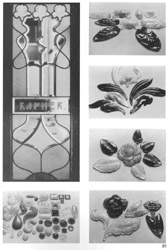 In that book, it showed a photo on pg. 81 of an old storefront stained glass door panel from an importer’s business in Vienna (photo at right). The business was run by Johann and C. Kapner. Across the top of that stained glass window are three irises, exactly like the one I had just purchased. Kapner was in the business of importing these glass forms, but he was not the manufacturer. The iris pieces were used in the same method in what I had been thinking about doing with the one I had just purchased. Kapner is no longer in business and the door panel is now in the private collection of a Mr. Balluch, also from Vienna. Other pieces in the store were also purchased by Balluch when the shop closed. These other flora forms are shown in the photos surrounding the door panel illustration. Sellner’s information also mentioned that Tiffany was well known for using pressed glass parts for decorative purposes, such as fireplace surround panels and lamps. The author compared the bloom patterns that Tiffany produced to this iris and other glass glazing items in Mr. Balluch’s collection, but indicated that it was not Tiffany who made these flower forms from glass. No other applications of this IRIS glass glazing piece has been discovered anywhere in Europe. This may be due to the complicated and irregular shape of the various pieces and the difficulty in using them for their intended purpose. The article mentioned that a certain amount of cement was needed to hold the IRIS grouping in place on the door panel. These glass items were in vogue around 1900, during the time of the Paris World Exhibition and the beginning of the Art Nouveau period.
In that book, it showed a photo on pg. 81 of an old storefront stained glass door panel from an importer’s business in Vienna (photo at right). The business was run by Johann and C. Kapner. Across the top of that stained glass window are three irises, exactly like the one I had just purchased. Kapner was in the business of importing these glass forms, but he was not the manufacturer. The iris pieces were used in the same method in what I had been thinking about doing with the one I had just purchased. Kapner is no longer in business and the door panel is now in the private collection of a Mr. Balluch, also from Vienna. Other pieces in the store were also purchased by Balluch when the shop closed. These other flora forms are shown in the photos surrounding the door panel illustration. Sellner’s information also mentioned that Tiffany was well known for using pressed glass parts for decorative purposes, such as fireplace surround panels and lamps. The author compared the bloom patterns that Tiffany produced to this iris and other glass glazing items in Mr. Balluch’s collection, but indicated that it was not Tiffany who made these flower forms from glass. No other applications of this IRIS glass glazing piece has been discovered anywhere in Europe. This may be due to the complicated and irregular shape of the various pieces and the difficulty in using them for their intended purpose. The article mentioned that a certain amount of cement was needed to hold the IRIS grouping in place on the door panel. These glass items were in vogue around 1900, during the time of the Paris World Exhibition and the beginning of the Art Nouveau period.
One bit of information from that article proved to be a turning point in finding out where these were made. A few of the pieces had an original label on the back side: OSCAR HAASE, NEW YORK, NY. Sellner wondered in her book if this was an exporter or other commercial business that had supplied them to Kapner, but did not have any additional information.
With the name of “Oscar Haase,” as a clue, I had my wife, Vickie (also known as “ace detective & genealogy queen”) do some genealogical searching for Oscar Haase in the United States. This is what she found out about Haase: Oscar arrived as an immigrant in New York on the FURST BISMARCK, a ship built for the Hamburg-American line and sailed under the German Flag. Oscar’s port of departure was Hamburg, Germany.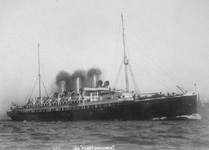 Haase arrived in NY on September 14, 1895 with four bags. His occupation was listed on the ship manifest as merchant and his age was listed as 35. He became a naturalized citizen in October, 1895. (At that time, a person did not have to wait 5 years to become a citizen). The census records for 1900 show that he was living in Manhattan, New York. This record showed a month/year of birth as 1858 (“close enough” – math from above date of arrival would have given a birth year of 1860). He was married in 1896 to ‘Mary’. (1900 census listed that they had been married for 4 years – exact date not shown.) Mary was born in New York. Her father was born in New York and her mother born in Ireland (no other info on Mary, such as maiden name).
Haase arrived in NY on September 14, 1895 with four bags. His occupation was listed on the ship manifest as merchant and his age was listed as 35. He became a naturalized citizen in October, 1895. (At that time, a person did not have to wait 5 years to become a citizen). The census records for 1900 show that he was living in Manhattan, New York. This record showed a month/year of birth as 1858 (“close enough” – math from above date of arrival would have given a birth year of 1860). He was married in 1896 to ‘Mary’. (1900 census listed that they had been married for 4 years – exact date not shown.) Mary was born in New York. Her father was born in New York and her mother born in Ireland (no other info on Mary, such as maiden name).
There was no other ‘Haase’ shown on the ship’s manifest. His occupation in 1900 was listed on the census as IMPORTER/ EXPORTER. The 1910 census shows him living in Bedford (Township), Westchester County, New York.
In the 1910 census, Oscar’s occupation was listed as MANUFACTURER/GLASSWORKS. The mystery was solved!! From this information, we can deduce that Oscar probably moved to Bedford for additional space to run a small Glassworks company and he made (among other things) glass Art Nouveau glazing items!
In the 1920 census, it showed him back in Manhattan, New York, and his occupation was again shown as IMPORTER/EXPORTER. Both Oscar and Mary appear to have passed away between 1920-1930, as they do not appear on any census record for 1930. No children were listed on any census. Each census that Oscar was listed on showed that he rented his residence.
My wife and I have discussions about ancestors and what it must have been like during centuries past. We were contemplating that she has thousands of examples of various immigrants that came to America, and how those individuals left a mark on our world with all of his/her descendants (and the accomplishments of some of those descendants).
Then, there are people like Oscar Haase, who was the only immigrant from his family, got married, but because he had no children, he faded into virtual obscurity. However, because he happened to put an advertising label on his glass glazier items (and a few labels survived), he was not lost to history. To quote the “Butterfly Effect”: “When a Butterfly flutters it’s wings in one part of the world, it can eventually cause a hurricane in another.”
His ‘legacy’ has now expanded past the side note mentioned in Sellner’s book, showing he was a full-fledged glass works manufacturer! Soon, there will be thousands of people who will now know who OSCAR HAASE was, and the legacy that he left to all of us!
I want to thank both Siegmar and my wife for their help on solving the mystery on who made this great little piece of Art Nouveau Glass! — Dave Peterson
UPDATE!
Siegmar Geiselberger just sent additional photos of more pieces of
OSCAR’S LEGACY, shown here:
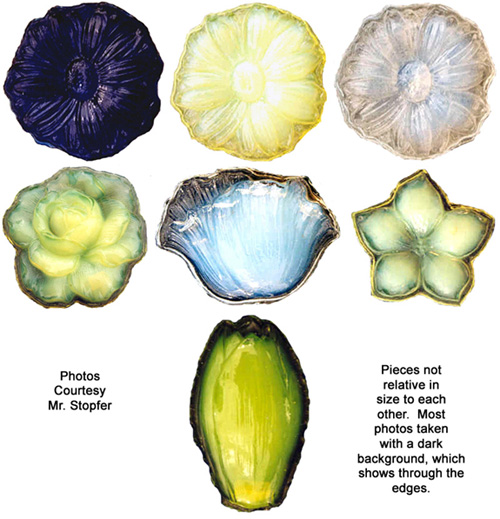
This photo shows what I finally did with my new Oscar Iris!
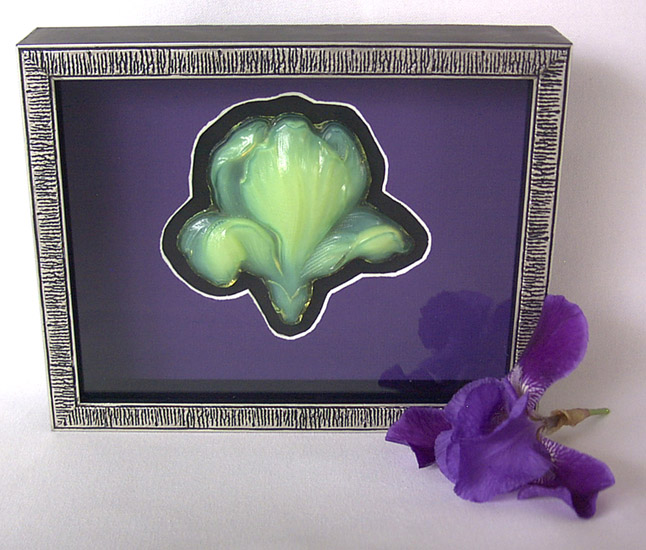
(photos of GLASS iris at top and bottom of page, + photo link of Iris with Meander by Jefferson glass, and the real iris flowers at left were taken by the author and cannot be used without written permission. Book cover photo link and pg. 81 of that book shown above is copyright 1986 by Christiane Sellner.)
